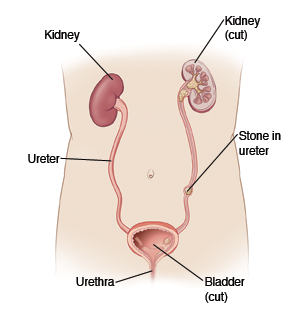Kidney Stone, Passed

A kidney stone (nephrolithiasis) starts as tiny crystals. They form inside the kidney where urine is made. Most kidney stones enlarge to about 1/8 to 1/4 inch in size before leaving the kidney and moving toward the bladder. The sharp, cramping pain and nausea/vomiting you had was the stone moving through the ureter. The ureter is the narrow tube joining the kidney to the bladder. Once the stone reaches your bladder, the pain stops. Pain may start again as the stone passes through the bladder and out through the urethra.
There are four types of kidney stones. Most are calcium stones. They are mostly made up of calcium oxalate. But some are made with calcium phosphate. The other three types include uric acid stones, struvite stones (from a preceding infection), and rarely, cystine stones.
Home care
These guidelines will help you care for yourself at home:
-
Drink plenty of fluids. This increases urine flow. It also reduces the chance that a new stone will form. Healthy adults (no heart/liver/kidney disease) who have had a kidney stone should drink 12 8-ounce glasses of fluids per day. Most of this should be water. The goal is to produce 1.5 to 2 quarts of almost colorless urine per 24 hours.
-
Unless another NSAID (non-steroidal anti-inflammatory drug) was given, you may take ibuprofen or naproxen. This is in addition to any narcotic pain medicine your healthcare provider prescribes. If you have chronic liver or kidney disease, or ever had a stomach ulcer or digestive bleeding, talk with your healthcare provider before using these medicines.
-
Collect the stone. If you were given a strainer, urinate into a jar then pour the urine through the strainer and into the toilet. Keep doing this for 24 hours after your pain stops. Save any stone that you find in the strainer. Bring it to your healthcare provider for analysis. Assessing the stone can help understand why it developed and how to reduce your risk for more stones. If you don't collect a stone, a 24-hour urine specimen can be done at a later time by your healthcare provider to figure out the cause of your stone.
Prevention
Each year, there is a chance that a new stone will form. The risk is highest if you have a family history of kidney stones or have certain chronic illnesses such as high blood pressure, obesity, or diabetes. However, lifestyle and dietary changes can reduce the risk of getting another kidney stone.
Most kidney stones are made of calcium. The following advice can help you prevent calcium stones. If you don’t know the type of stone you have, follow this advice until the healthcare provider determines the cause of your stone.
Things that help:
-
The most important thing you can do is to drink plenty of fluids each day, as described above.
-
Foods such as wheat, rice, rye, barley, and beans contain phytate. Phytate is a compound that may lower the risk for getting any type of stone.
-
Eat more fruits and vegetables, especially those high in potassium.
-
Eat foods high in natural citrate, such as fruit and fruit juices (using low sugar).
-
Low calcium contributes to calcium type kidney stones. Eat a normal calcium diet and talk with your healthcare provider if you are taking calcium supplements. It may be harmful to lower your calcium intake. New research shows that eating calcium-rich and oxalate-rich foods together lowers your risk for stones. This is because eating these foods together binds the minerals in the stomach and intestines before they can reach the kidneys.
-
Limit salt intake to 2 grams (1 teaspoon) per day. Extra sodium can cause you to lose more calcium in your urine. This increases your chances of developing a stone. Use limited amounts when cooking, and don’t add salt at the table. Processed and canned foods are usually high in salt.
-
Eat fewer high-oxalate foods. These include spinach, rhubarb, peanuts, beets, cashews, almonds, grapefruit, chocolate, tea, and grapefruit juice. Or eat them with calcium-rich foods. These foods include dairy, dark leafy greens, soy products, and calcium-enriched foods.
-
Reduce the amount of animal meat and high-protein foods in your diet. This will lower your risk for uric acid stones. Animal meat and high-protein foods have high amounts of a compound called purines. Eating foods high in purines causes your body to make more uric acid.
-
Don't have extra sugar (sucrose) or fructose (sweetener in many soft drinks) in your diet.
-
If you take vitamin C as a supplement, don't take more than 1,000 milligrams (mg) per day. More than 1,000 mg per day may cause your body to make more oxalate.
-
A dietitian or your healthcare provider can give you ideas on how to change your diet to prevent more kidney stones.
Follow-up care
Follow up with your healthcare provider, or as advised. Even if you don't collect the kidney stone, it's possible to analyze a 24-hour urine collection for the cause of this stone. Discuss this with your healthcare provider.
If you had an X-ray, CT scan, or other diagnostic test, you will be told of any findings that may affect your care.
Call 911
Call 911 if you have any of these:
When to seek medical advice
Call your healthcare provider right away if any of these occur:
-
Severe pain that returns and is not relieved by pain medicines
-
Repeated vomiting or unable to keep down fluids
-
Fever of 100.4ºF (38ºC) or higher, or as directed by your healthcare provider
-
Blood clots in urine
-
Foul smelling or cloudy urine
-
Unable to pass urine for 8 hours or increasing bladder pressure